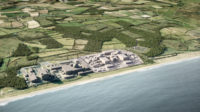The world’s first tidal lagoon power plant could move forward as a result of the United Kingdom’s planned departure from the European Union, maybe in 2019. A recent official report cited “a post-Brexit world” as one justification for building a pilot tidal plant. A $1.3-billion scheme in Swansea Bay is almost shovel-ready.
“The evidence is clear that tidal lagoons can play a cost-effective role in the U.K.’s energy mix,” says former government minister Charles Hendry in his report, “The Role of Tidal Lagoons.” While lagoons can cut emissions and boost industrial growth, they face “very considerable challenges” in fitting in with the country’s energy mix and providing value for the investment, he adds.
Hendry’s report represents “the final piece of the jigsaw,” says a spokeswoman for plant developer Tidal Lagoon (Swansea Bay) plc., or TLSB. The report should improve the company’s chances of securing government agreement for a viable guaranteed minimum energy price from the 320-MW Swansea Bay pilot project, she adds.
Tidal lagoons are “very competitive” with other low-carbon options, claims Hendry. But with a 120-year operating life, much longer than other technologies, economic comparisons are difficult, he adds.
In its own analysis, TLSB reckons the lifetime consumer cost of electricity from the Swansea lagoon would equal that of new nuclear while undercutting offshore wind power by around 30%.
Sited off the coast of South Wales, the Swansea scheme would enclose 11.5 sq kilometers of bay with a 9.5-km-long breakwater wall, containing generators to harness the 8.5-meter tidal range’s power. Aiming to secure a fixed output price, TLSB is also negotiating with local environmental groups over potential impacts to fisheries.
If all goes well, contracts could be signed this year, says the spokeswoman. Two institutional investors have committed $250 million in equity for the scheme, and lenders are being sought for the balance, she adds.
At the same time, TLSB is looking for a marine contractor to build the $375-million breakwater wall, having parted company with its former preferred bidder, China Harbour Engineering Co. Ltd. Laing O’Rourke plc., Dartford, is still the preferred bidder for the $250-million contract that covers the 410-m-long concrete turbine house and sluice structure.
As the U.K.’s tidal range—second only to Canada’s—seems set for exploitation, subsea tidal-stream technology is quietly making progress off Scotland.
In the stretch of water between the north of Scotland and the Orkney Islands, Edinburgh-based Atlantis Resources Ltd. late last year began to deliver power from the first phase of its 6-MW MeyGen demonstration scheme.
The project in Pentland Firth includes four 18-m-dia, seabed-anchored turbines that are 8 m below the surface. A new $22-million grant from the European Commission will allow Atlantis this year to build a second, adjacent 6-MW phase.
The new phase, due for completion next year, “will help the tidal-stream industry demonstrate reductions in the price per unit of electricity by increasing the energy yield,” according to Tim Cornelius, Atlantis CEO.
While U.K tidal power is looking up, a report from the Energy Technologies Institute (ETI), a government-and-industry body based in Loughborough, dampened prospects for wave power.
Tidal stream projects such as MeyGen have the “potential to compete with other low-carbon energy sources,” claims ETI. Further, tidal lagoons “lie in between the development stages of tidal stream and wave energy,” it adds.
Wave energy is technically viable, notes ITU, adding, “It is … up to 10 times more expensive than other low-carbon alternatives, so there needs to be a radical rethink if it is to become cost-competitive.”






Post a comment to this article
Report Abusive Comment